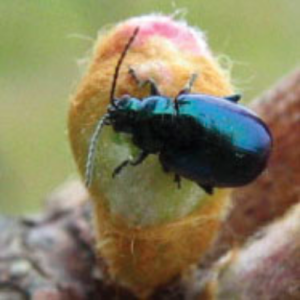The time has come to hang apple maggot fly (AMF) traps in Vermont orchards. These are some of the easiest pests to manage using an IPM strategy, so there’s really no excuse. The idea is to assess the population in the orchard before applying prophylactic sprays. By using red sticky traps, you can time treatments for best effectiveness, and maybe even skip treatments if the populations are low enough. Traps are red plastic balls that you coat with Tanglefoot adhesive. Kits including traps and adhesive are available from Gemplers and Great Lakes IPM. We have some available from our program as well, if you want to swing by South Burlington. If you want to come by for traps, please email me and we’ll be sure to have some ready.
AMF traps should be hung at least four per 10-acre block, preferably at the orchard perimeter and especially near sources of the insect, like wild or unmanaged apples. (Video here: Vermont Apple IPM: Hanging apple maggot fly traps.) Placement in the tree should be about head-height, and surrounding foliage should be trimmed away- this trap is largely visual, and you should be able to see it from 10-20 yards away. The traps may be baited with an apple essence lure that improves their attractiveness dramatically. When using traps to monitor AMF populations to time sprays, unbaited traps that catch one fly per block (as an average of all the traps in the block) would warrant treatment; the lure makes them much more attractive such that you can wait until an average of five flies per trap are caught before treating. For most growers, the main insecticide used against AMF is Assail, Imidan also works but it has a long reentry interval and tends to leave visible residue on fruit. For organic growers, Surround works well, but its use in midsummer may increase European red mites, and it can be hard to remove at harvest; spinosad (Entrust) works pretty well too. First AMF treatment is still a few weeks off, most likely.
It is summer lepidoptera season, and monitoring and treatment should be on everyone’s minds, especially for codling moth (CM) and obliquebanded leafroller (OBLR). CM are active and eggs are likely still hatching across the state, so growers who have caught CM in their traps or who often have issues with this pest (that’s most everyone) should apply something effective against them at the appropriate time. Most orchards saw CM first trap captures in late May and peak at the beginning of June. Optimum spray timing for CM is 250 degree days (base 50°) after first catch with a follow up spray 10-14 days later. Very specific materials like insect growth regulators (Intrepid, Rimon) or granulosis virus (Madex, Cyd-X) can be used that are very safe to non-target insects. One or two applications of a material should suffice for first generation.
OBLR are just showing up in traps but generally at low levels compared to previous years, and treatment should be timed at 360 degree days (base 43°F) after first catch. There is a NEWA model for this pest, and a material like Bt (Dipel, etc.) is effective (but not against CM). Other good materials targeted at this lepidopteran pest include Intrepid, Rimon, Delegate, and Belt.
I have seen one pretty bad case of European red mites already, and hot, dry weather is also conducive to mite flare-ups. A weekly or, if the numbers indicate, bi-weekly scouting will help to indicate if there are high enough mite numbers to consider treatment. Information on monitoring: https://netreefruit.org/apples/insects/mites. Mites should be treated based on the following thresholds: in June, 1-2 mites per leaf; July, 5 mites per leaf; in August, trees are more tolerant of feeding so treatment should only be applied if there are over 7.5 mites per leaf.
Diseases: keep checking on your scab, if you have none (I mean none), then it’s okay to relax. That said, the summer diseases sooty blotch and flyspeck are of concern now, but they require 270 hours of leaf wetness for lesions to form, so fungicide coverage between that period should be maintained. I am also seeing more leaf spot diseases (here’s a great article on the different leaf spots you may encounter) this year that may warrant continued coverage to reduce potential defoliation and/or spread to fruit rots. Recommendations from our colleagues at Cornell suggest including a FRAC group 3, 7, or 11 fungicide with your captan cover to reduce incidence of these diseases. Keep in mind that one inch of rain washes off half of your coverage, after two inches, it’s gone.
It’s time to wrap up any ground-applied nitrogen fertilizers, but potassium and magnesium fertilizers can be applied any time in summer. It’s also a good idea to start your regular foliar calcium sprays, especially on bitter pit-prone cultivars like Honeycrisp and Cortland.
The UVM Tree Fruit and Viticulture Program is supported by the University of Vermont Agriculture Experiment Station, UVM Extension, USDA NIFA E-IPM Program, and USDA Risk Management Agency.
Issued in furtherance of Cooperative Extension work, Acts of May 8 and June 30, 1914, in cooperation with the United States Department of Agriculture. University of Vermont Extension, Burlington, Vermont. University of Vermont Extension, and U.S. Department of Agriculture, cooperating, offer education and employment to everyone without regard to race, color, national origin, gender, religion, age, disability, political beliefs, sexual orientation, and marital or familial status.
Where trade names or commercial products are used for identification, no discrimination is intended and no endorsement is implied. Always read the label before using any pesticide. The label is the legal document for the product use. Disregard any information in this message if it is in conflict with the label.








